The Ottoman Empire
The Treaty of Lausanne in 1923 and its consequences in July 2023
Overview of Turkey’s territories and why these territories were not claimed back in July 2023
by
Prof. Dr. Robert Gorter, MD, PhD.
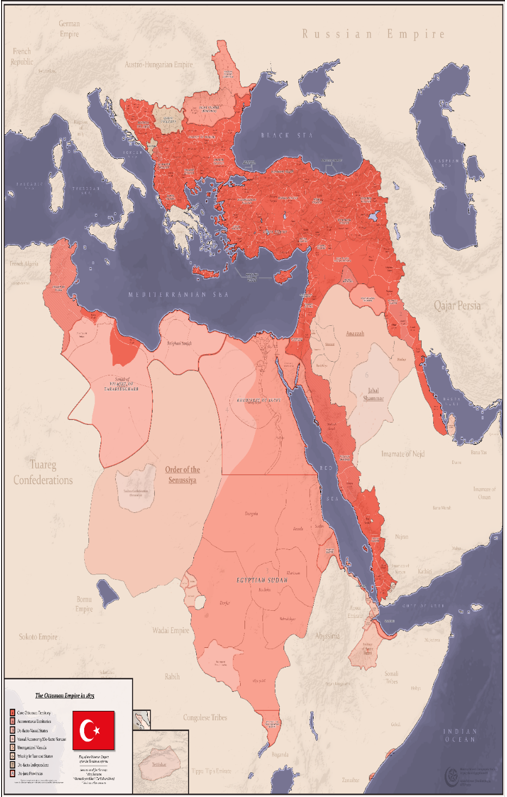
From Wikipedia, the free encyclopedia
The Ottoman Empire, historically and colloquially the Turkish Empire, was an empire that controlled much of Southeast Europe, Western Asia, and Northern Africa between the 14th and early 20th centuries. It was founded at the end of the 13th century in northwestern Anatolia in the town of Söğüt (modern-day Bilecik Province) by the Turkoman tribal leader Osman I. After 1354, the Ottomans crossed into Europe and, with the conquest of the Balkans, the Ottoman Beylik was transformed into a transcontinental empire. The Ottomans ended the Byzantine Empire with the conquest of Constantinople in 1453 by Mehmed the Conqueror.
Under the reign of Suleiman the Magnificent, the Ottoman Empire marked the peak of its power and prosperity, as well as the highest development of its governmental, social, and economic systems. At the beginning of the 17th century, the empire contained 32 provinces and numerous vassal states. Some of these were later absorbed into the Ottoman Empire, while others were granted various types of autonomy over the course of centuries. With Constantinople (modern-day Istanbul) as its capital and control of lands around the Mediterranean Basin, the Ottoman Empire was at the center of interactions between the Middle East and Europe for six centuries.
While the empire was once thought to have entered a period of decline following the death of Suleiman the Magnificent, this view is no longer supported by the majority of academic historians. The newer academic consensus posits that the empire continued to maintain a flexible and strong economy, society and military throughout the 17th and for much of the 18th century. However, during a long period of peace from 1740 to 1768, the Ottoman military system fell behind that of its European rivals, the Habsburg and Russian empires. The Ottomans consequently suffered severe military defeats in the late 18th and early 19th centuries. The successful Greek War of Independence concluded with decolonization of Greece following the London Protocol (1830) and Treaty of Constantinople (1832). This and other defeats prompted the Ottoman state to initiate a comprehensive process of reform and modernization known as the Tanzimat. Thus, over the course of the 19th century, the Ottoman state became vastly more powerful and organized internally, despite suffering further territorial losses, especially in the Balkans, where a number of new states emerged.
The Committee of Union and Progress (CUP) established the Second Constitutional Era in the Young Turk Revolution in 1908, turning the Empire into a constitutional monarchy, which conducted competitive multi-party elections. However, after the disastrous Balkan Wars, the now radicalized and nationalistic CUP took over the government in the 1913 coup d’état, creating a one-party regime. The CUP allied the Empire with Germany, hoping to escape from the diplomatic isolation which had contributed to its recent territorial losses, and thus joined World War I on the side of the Central Powers. While the Empire was able to largely hold its own during the conflict, it was struggling with internal dissent, especially with the Arab Revolt in its Arabian holdings. During this time, the Ottoman government engaged in genocide against the Armenians, Assyrians, and Greeks. The Empire’s defeat and the occupation of part of its territory by the Allied Powers in the aftermath of World War I resulted in its partitioning and the loss of its Middle Eastern territories, which were divided between the United Kingdom and France. The successful Turkish War of Independence, led by Mustafa Kemal Atatürk against the occupying Allies, led to the emergence of the Republic of Turkey in the Anatolian heartland and the abolition of the Ottoman monarchy.
Defeat and dissolution (1908–1922)
Young Turk movement
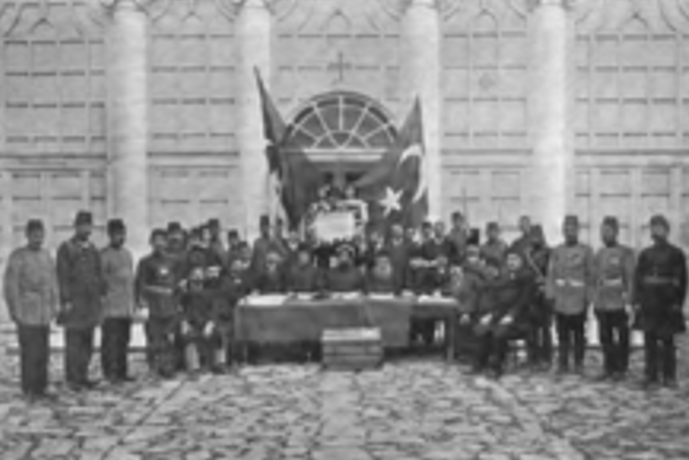
The defeat and dissolution of the Ottoman Empire (1908—1922) began with the Second Constitutional Era, a moment of hope and promise established with
the Young Turk Revolution. It restored the Constitution of the Ottoman Empire and brought in multi-party politics with a two-stage electoral system (electoral law) under the Ottoman parliament. The constitution offered hope by freeing the empire’s citizens to modernize the state’s institutions, rejuvenate its strength, and enable it to hold its own against outside powers. Its guarantee of liberties promised to dissolve inter-communal tensions and transform the empire into a more harmonious place. Instead, this period became the story of the twilight struggle of the Empire.
Members of Young Turks movement who had once gone underground now established their parties. Among them “Committee of Union and Progress“, and “Freedom and Accord Party” were major parties. On the other end of the spectrum were ethnic parties, which included Poale Zion, Al-Fatat, and Armenian national movement organized under Armenian Revolutionary Federation. Profiting from the civil strife, Austria-Hungary officially annexed Bosnia and Herzegovina in 1908. The last of the Ottoman censuses was performed in 1914. Despite military reforms which reconstituted the Ottoman Modern Army, the Empire lost its North African territories and the Dodecanese in the Italo-Turkish War (1911) and almost all of its European territories in the Balkan Wars (1912–1913). The Empire faced continuous unrest in the years leading up to World War I, including the 31 March Incident and two further coups in 1912 and 1913.
World War I
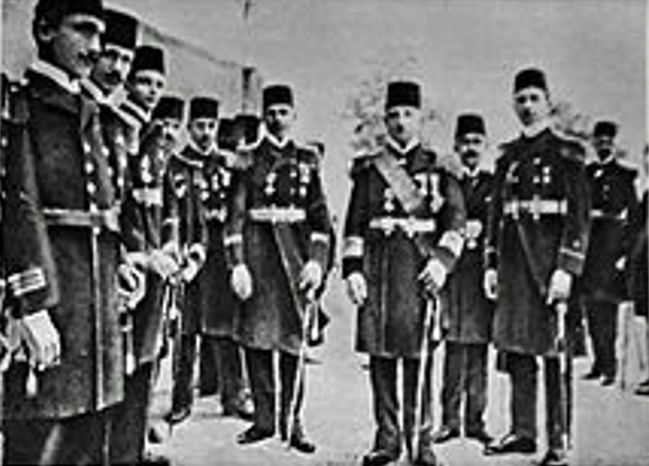
Admiral Wilhelm Souchon, who commanded the Black Sea raid on 29 October 1914, and his officers in Ottoman naval uniforms
The Ottoman Empire entered World War I on the side of the Central Powers and was ultimately defeated. The Ottoman participation in the war began with the combined German-Ottoman surprise attack on the Black Sea coast of the Russian Empire on 29 October 1914. Following the attack, the Russian Empire (2 November 1914)[156] and its allies France (5 November 1914)[156] and the British Empire (5 November 1914)[156] declared war on the Ottoman Empire (also on 5 November 1914, the British government changed the status of the Khedivate of Egypt and Cyprus, which were de jure Ottoman territories prior to the war, as British protectorates.)
The Ottomans successfully defended the Dardanelles strait during the Gallipoli campaign (1915–1916) and achieved initial victories against British forces in the first two years of the Mesopotamian campaign, such as the Siege of Kut (1915–1916); but the Arab Revolt (1916–1918) turned the tide against the Ottomans in the Middle East. In the Caucasus campaign, however, the Russian forces had the upper hand from the beginning, especially after the Battle of Sarikamish (1914–1915). Russian forces advanced into northeastern Anatolia and controlled the major cities there until retreating from World War I with the Treaty of Brest-Litovsk following the Russian Revolution in 1917.
Genocides


In 1915, the Ottoman government and Kurdish tribes in the region started the extermination of its ethnic Armenian population, resulting in the deaths of up to 1.5 million Armenians in the Armenian genocide. The genocide was carried out during and after World War I and implemented in two phases: the wholesale killing of the able-bodied male population through massacre and subjection of army conscripts to forced labor, followed by the deportation of women, children, the elderly and infirm on death marches leading to the Syrian desert. Driven forward by military escorts, the deportees were deprived of food and water and subjected to periodic robbery, rape, and systematic massacre. Large-scale massacres were also committed against the Empire’s Greek and Assyrian minorities as part of the same campaign of ethnic cleansing.
Arab Revolt
The Arab Revolt began in 1916 with British support. It turned the tide against the Ottomans on the Middle Eastern front, where they seemed to have the upper hand during the first two years of the war. On the basis of the McMahon–Hussein Correspondence, an agreement between the British government and Hussein bin Ali, Sharif of Mecca, the revolt was officially initiated at Mecca on June 10th, 1916. The Arab nationalist goal was to create a single unified and independent Arab state stretching from Aleppo in Syria to Aden in Yemen, which the British had promised to recognize.
The Sharifian Army led by Hussein and the Hashemites, with military backing from the British Egyptian Expeditionary Force, successfully fought and expelled the Ottoman military presence from much of the Hejaz and Transjordan. The rebellion eventually took Damascus and set up a short-lived monarchy led by Faisal, a son of Hussein.
Following the Sykes–Picot Agreement, the Middle East was later partitioned by the British and French into mandate territories. There was no unified Arab state, much to the anger of Arab nationalists.
Treaty of Sèvres and Turkish War of Independence

Defeated in World War I, the Ottoman Empire signed the Armistice of Mudros on 30 October 1918. Constantinople was occupied by combined British, French, Italian, American and Greek forces. In May 1919, Greece also took control of the area around Smyrna (now İzmir).
The partition of the Ottoman Empire was finalized under the terms of the 1920 Treaty of Sèvres. This treaty, as designed in the Conference of London, allowed the Sultan to retain his position and title. The status of Anatolia was problematic given the occupied forces.
As a follow-up to the Treaty of Sèvres, the Treaty of Lausanne was a peace treaty negotiated during the Lausanne Conference of 1922–23 and signed in the Palais de Rumine, Lausanne, Switzerland, on 24 July 1923.
There arose a nationalist opposition in the Turkish national movement. It won the Turkish War of Independence (1919–1923) under the leadership of Mustafa Kemal (later given the surname “Atatürk“). The sultanate was abolished on 1 November 1922, and the last sultan, Mehmed VI (reigned 1918–1922), left the country on 17 November 1922. The Republic of Turkey was established in its place on 29 October 1923, in the new capital city of Ankara. The caliphate was abolished on 3 March 1924.
What will happen in July of 2023 when the Treaty of Lausanne ends?
As a looser of WWI, Turkey gave up essentially all its territories in North Africa, Sub-Sahara countries like Sudan and all the Arabic nations it had occupied, to the Allies.
This meant that all oil and gas-rich countries were now under the rule of the Allies and especially the British divided the Arab world in several separate nations under the motto: “Divide and Control.” Several countries which were created we know today as Iraq, Lebanon, Syria, Iran, Yemen, major parts of Saudi Arabia and the United Arab Emirates.
Thus, Turkey was now left to become an oil-importing nation from its previous territories.
The Treaty of Lausanne determined that after 100 years, Turkish authority over all its lost territories would be restored. This will thus be technically on July 24th, 2023.
Are the latest earthquakes in Southern Turkey man-made by HAARP and must be considered in the light of Turkish recovery its authority of essentially 90% of all oil and gas-fields in these areas (Middle East, Northern Africa, Iran and Iraq up to Afghanistan)?
High-frequency Active Auroral Research Program (HAARP) was initiated as an ionospheric research program jointly funded by the United States Air Force, United States Navy, University of Alaska Fairbanks, and the Defense Advanced Research Projects Agency (DARPA). ///// Sea-Based X-Band Radar (SBX-1) is a floating, self-propelled, mobile active electronically scanned early warning radar station designed to operate in high winds and heavy seas. It was developed as part of the United States Department of Defense Missile Defense Agency (MDA) Ballistic Missile Defense System.

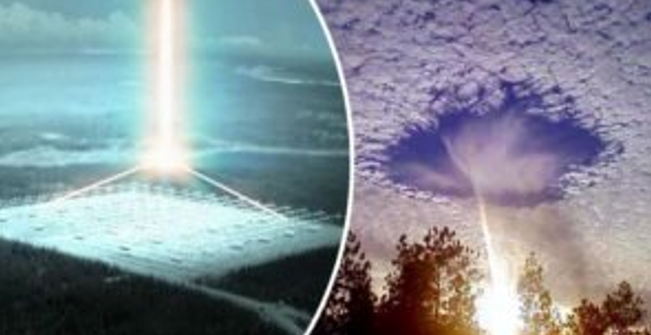

In an Arctic compound 450 kilometers east of Anchorage, Alaska, the Pentagon has erected a powerful transmitter designed to beam more than one gigawatt of energy into the upper reaches of the atmosphere.
Known as Project HAARP (High-frequency Active Auroral Research Program), the experiment involves the world’s largest “ionospheric heater,” a device designed to zap the skies hundreds of kilometers above the Earth with high-frequency radio waves.
Why irradiate the charged particles of the ionosphere (which when energized by natural processes make up the lovely and famous phenomenon known as the Northern Lights)?
According to the US Navy and Air Force, co-sponsors of the project, “to observe the complex natural variations of Alaska’s ionosphere.”
As well, admit the Pentagon, to develop new forms of communications and surveillance technologies to enable the military to send signals to nuclear submarines and to peer deep underground.
Ever since the existence of HAARP became public, a number of independent researchers have warned the operation has a secret agenda including:

Many independent researchers believe HAARP transmissions are actually being used to activate or trigger exactly the same electromagnetic conditions that can cause tectonic movement and hurricanes.
As anti-HAARP activists claim, HAARP is the most dangerous project that the US government has undertaken so far. Hidden by the innocent name of HAARP is the ultimate death ray.
When HAARP’s shot up, it can move clouds. When aimed at the ground it can cause earthquakes and tsunamis. According to Jerry Smith, an anti-HAARP activist says that the US military’s desire is to harness the weather and use it as a weapon.
Smith in his book HAARP – The Ultimate Weapon of the Conspiracy, warns many atmospheric scientists working on the secretive military project might be unaware of HAARP’s grave potential to wreak havoc on the Earth.
He writes:
“If HAARP is a TMT (Tesla Magnifying Transmitter), and these researchers correctly understand Tesla’s work, we could be in a lot of trouble. It is quite possible that the scientists working on HAARP do not know what they are playing with.
“Beyond that their ignorance might be compounded if HAARP is indeed a secretive black-ops military project. The military has devised a way of keeping secrets called ‘compartmentalization’ where each unit knows only what it needs to know… Only the control group knows what’s going on…”
“If there is a control group familiar with TMTs directing the actions of scientists unschooled in Tesla technology, those lower level operatives could be directed to wreak havoc with created weather or manufactured earthquakes…
The key technology behind HAARP is the brainchild of scientist Bernard Eastlund.
Judging from his APTI patent, Tesla was a major inspiration for Eastlund’s ionospheric heater. A New York Times story, dated December 8, 1915, describes one of Tesla’s ideas which are remarkably similar to Eastlund’s.
In 1966, Professor Gordon J.F. MacDonald was associate director of the Institute of Geophysics and Planetary Physics at the University of California, Los Angeles, a member of the US President’s Science Advisory Committee, and later a member of the US President’s Council on Environmental Quality.
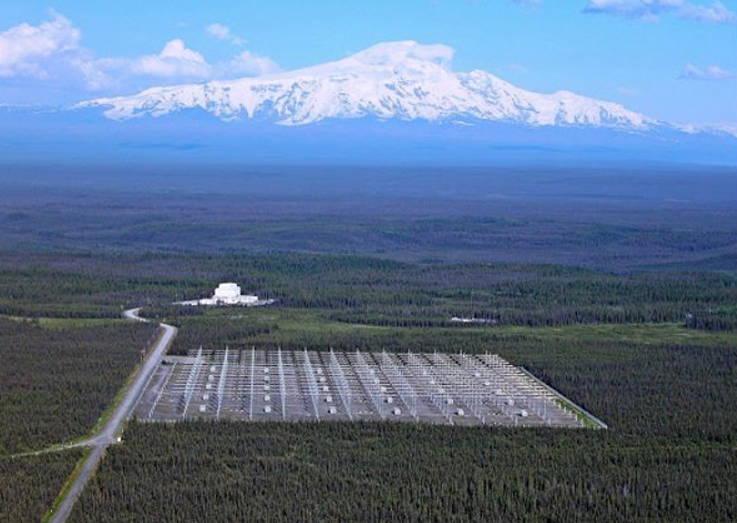
“The key to geophysical warfare is the identification of environmental instabilities to which the addition of a small amount of energy would release vastly greater amounts of energy, like earth quakes.”
World-renowned scientist MacDonald developed ideas for using the environment as a weapon system and he contributed to what was, at the time, only in the wildest dream of a futurist.
When he wrote his chapter, “How to Wreck the Environment,” for the book Unless Peace Comes, he was not kidding around.
He speculated these types of weapons would be developed and, when used, would be virtually undetectable by their victims.
Is HAARP one such weapon?
In her book Planet Earth: “The Latest Weapon of War”, renowned scientist and nuclear activist Dr. Rosalie Bertell says such electromagnetic weapons:
“have the ability to transmit explosive and other effects such as earthquake induction across intercontinental distances to any selected target site on the globe with force levels equivalent to major nuclear explosions.”


Her book explains that pulsed, extremely low frequency (ELF) waves can be used to convey mechanical effects and vibrations at great distances through the Earth.
Such manipulation of the Earth, she states, “has the capability to cause disturbance of volcanoes and tectonic plates, which in turn, have an effect on the weather,” creating earthquakes, large fires, storms and torrential rains over an area.
Does anyone notice the world’s weather has been very strange in the last years? Can we be sure that the climate is changing due to the activities of people, and not because of such devices as HAARP?
Is HAARP organized and lead by DARPA? There are strong indications, that indeed, DARPA (including CIA) is the main motor behind these developments.
